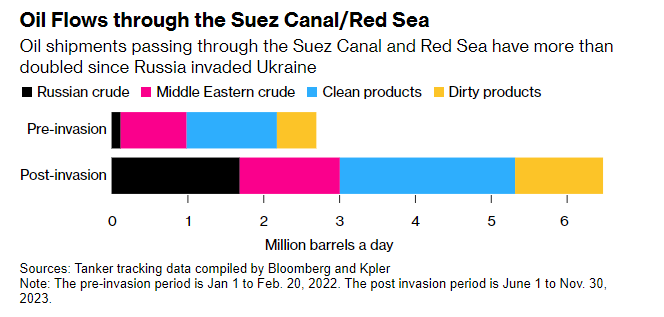Scenario Analysis: Israel Gaza War
The tension in the Middle East has driven up crude prices on risk premiums, kickstarting heightened oil trading which in turn supported tanker ton-mile demand. We are still in the middle of the conflict and there are multiple scenarios that could play out in the near future. An oil embargo against Israel, a disruption in the Strait of Hormuz by Iran, or a Suez Canal closure would have significant consequences in tanker demand and freight levels.
Scenario 1: oil embargo administered on Israel
According to Platts, Israel currently imports around 300,000 b/d of crude, with 60% of the volume from Kazakhstan and Azerbaijan (Iraq volume ceased amid the closure of Kirkuk-Ceyhan oil pipeline). In an “Oil Embargo” scenario, we assume the US could fill the gap of 180,000 b/d of crude demand from Israel. Using our base case vessel assumptions, this switch of crude sources would increase the Aframax tanker demand from 4 vessel equivalent to 17, which is expected to significantly boost the Aframax freight and earnings in the US Gulf market.
Due to the escalating Gaza conflict, Israel is reported to potentially divert its oil imports from the main Mediterranean port, Askhelon, to Eilat port on the Red Sea (Israeli Paz Oil Refinery). Taking this potential rerouting into consideration, tanker demand could rise further to 31 equivalent Aframaxes, nearly eight times higher than required by current oil flows.
Scenario 2: potential disruptions in the Strait of Hormuz
Based on our AIS tracking data, we have captured on average 15.1 million b/d of crude sailed from the Arabian Gulf in 2023 through the Hormuz Strait. In a “Strait Disruption” scenario, we foresee Saudi and UAE would maximize the use (+3.8 mil b/d) of the East-West Pipeline and Abu Dhabi Crude Oil Pipeline, bypassing the Strait. Meanwhile, the sharp increase in the global crude deficit and elevated prices would lead to a heavy inventory drawdown by 1.53 million b/d.
As 66% of crude liftings transited through the Strait has been carried by VLCCs, we anticipate a sharp decline in VLCC demand but significant support in demand for mid-sized tankers. The widened freight structure due to the imbalances in demand could find charterers heavily utilizing cheaper VLCCs when possible (especially in the Atlantic Basin), gradually mitigating the demand gap among the three DPP sectors. As a result, we have converted Suezmax and Aframax demand into VLCC demand equivalent to measure the overall demand side impact for the entire DPP tanker fleet. We found that despite potential for 10% lower volume flowing, DPP tanker demand could be expected to grow by 29 VLCC vessel demand equivalents.
Scenario 3: Suez Canal closure
Major DPP tanker routes will be disrupted by the closure of the Suez Canal including Middle East>Westbound and Europe>Eastbound trades (Russian barrels to Asian destinations since 2022). In this scenario, we assume oil flows remain at current levels while sailing distances notably increase through the Cape of Good Hope. Meanwhile, the SUMED pipeline connecting the Ain Sokhna terminal in the Red Sea and Sidi Kerir in the Med is assumed to be undisrupted; tracked by our AIS data, we have seen VLCCs (Bahri as an example) discharge their cargoes at the Ain Sokhna, while these cargoes are picked up by another vessel at the Sidi Kerir port.
In order to measure the impact from a longer sailing distance, we converted tanker demand into vessel equivalent for each DPP segments. The mid-sized tankers, Suezmax and Aframax, will find the greatly support by additional 72 and 66 demand equivalent respectively, compared to only 4 additional VLCC demand. Similarly for the CPP segments, a Suez Canal closure would result in net vessel demand equivalent additions of +45 LR2s, +17 LR1s, and +30 MR2s.




